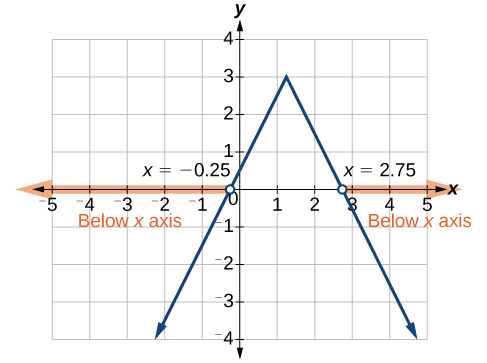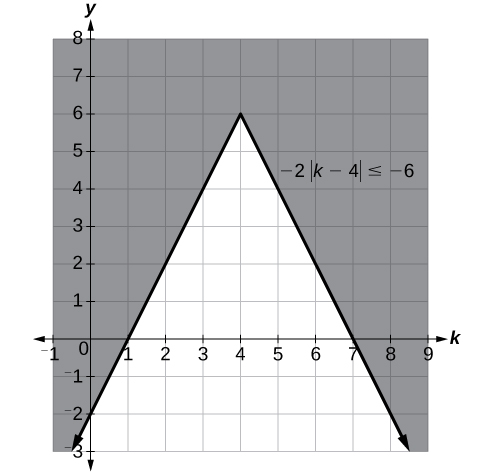Linear Inequalities and Absolute Value Inequalities
Learning Outcomes
- Use interval notation to express inequalities.
- Use properties of inequalities.
- Solve compound inequalities.
- Solve absolute value inequalities.

Writing and Manipulating Inequalities
Indicating the solution to an inequality such as [latex]x\ge 4[/latex] can be achieved in several ways. We can use a number line as shown below. The blue ray begins at [latex]x=4[/latex] and, as indicated by the arrowhead, continues to infinity, which illustrates that the solution set includes all real numbers greater than or equal to 4.| Set Indicated | Set-Builder Notation | Interval Notation |
|---|---|---|
| All real numbers between a and b, but not including a or b | [latex]\{x|a<x<b\}[/latex] | [latex]\left(a,b\right)[/latex] |
| All real numbers greater than a, but not including a | [latex]\{x|x>a\}[/latex] | [latex]\left(a,\infty \right)[/latex] |
| All real numbers less than b, but not including b | [latex]\{x|x<b\}[/latex] | [latex]\left(-\infty ,b\right)[/latex] |
| All real numbers greater than a, including a | [latex]\{x|x\ge a\}[/latex] | [latex]\left[a,\infty \right)[/latex] |
| All real numbers less than b, including b | [latex]\{x|x\le b\}[/latex] | [latex]\left(-\infty ,b\right][/latex] |
| All real numbers between a and b, including a | [latex]\{x|a\le x<b\}[/latex] | [latex]\left[a,b\right)[/latex] |
| All real numbers between a and b, including b | [latex]\{x|a<x\le b\}[/latex] | [latex]\left(a,b\right][/latex] |
| All real numbers between a and b, including a and b | [latex]\{x|a\le x\le b\}[/latex] | [latex]\left[a,b\right][/latex] |
| All real numbers less than a or greater than b | [latex]\{x|x<a\text{ and }x>b\}[/latex] | [latex]\left(-\infty ,a\right)\cup \left(b,\infty \right)[/latex] |
| All real numbers | [latex]\{x|x\text{ is all real numbers}\}[/latex] | [latex]\left(-\infty ,\infty \right)[/latex] |
Example: Using Interval Notation to Express All Real Numbers Greater Than or Equal to a Number
Use interval notation to indicate all real numbers greater than or equal to [latex]-2[/latex].Answer: Use a bracket on the left of [latex]-2[/latex] and parentheses after infinity: [latex]\left[-2,\infty \right)[/latex]. The bracket indicates that [latex]-2[/latex] is included in the set with all real numbers greater than [latex]-2[/latex] to infinity.
Try It
Use interval notation to indicate all real numbers between and including [latex]-3[/latex] and [latex]5[/latex].Answer: [latex-display]\left[-3,5\right][/latex-display]
Example: Using Interval Notation to Express All Real Numbers Less Than or Equal to a or Greater Than or Equal to b
Write the interval expressing all real numbers less than or equal to [latex]-1[/latex] or greater than or equal to [latex]1[/latex].Answer: We have to write two intervals for this example. The first interval must indicate all real numbers less than or equal to 1. So, this interval begins at [latex]-\infty [/latex] and ends at [latex]-1[/latex], which is written as [latex]\left(-\infty ,-1\right][/latex]. The second interval must show all real numbers greater than or equal to [latex]1[/latex], which is written as [latex]\left[1,\infty \right)[/latex]. However, we want to combine these two sets. We accomplish this by inserting the union symbol, [latex]\cup [/latex], between the two intervals.
Try It
Express all real numbers less than [latex]-2[/latex] or greater than or equal to 3 in interval notation.Answer: [latex-display]\left(-\infty ,-2\right)\cup \left[3,\infty \right)[/latex-display]
Using the Properties of Inequalities
When we work with inequalities, we can usually treat them similarly to but not exactly as we treat equations. We can use the addition property and the multiplication property to help us solve them. The one exception is when we multiply or divide by a negative number, we must reverse the inequality symbol.A General Note: Properties of Inequalities
[latex]\begin{array}{ll}\text{Addition Property}\hfill& \text{If }a< b,\text{ then }a+c< b+c.\hfill \\ \hfill & \hfill \\ \text{Multiplication Property}\hfill & \text{If }a< b\text{ and }c> 0,\text{ then }ac< bc.\hfill \\ \hfill & \text{If }a< b\text{ and }c< 0,\text{ then }ac> bc.\hfill \end{array}[/latex]
These properties also apply to [latex]a\le b[/latex], [latex]a>b[/latex], and [latex]a\ge b[/latex].Example: Demonstrating the Addition Property
Illustrate the addition property for inequalities by solving each of the following:- [latex]x - 15<4[/latex]
- [latex]6\ge x - 1[/latex]
- [latex]x+7>9[/latex]
Answer: The addition property for inequalities states that if an inequality exists, adding or subtracting the same number on both sides does not change the inequality. 1. [latex-display]\begin{array}{ll}x - 15<4\hfill & \hfill \\ x - 15+15<4+15 \hfill & \text{Add 15 to both sides.}\hfill \\ x<19\hfill & \hfill \end{array}[/latex-display] 2. [latex-display]\begin{array}{ll}6\ge x - 1\hfill & \hfill \\ 6+1\ge x - 1+1\hfill & \text{Add 1 to both sides}.\hfill \\ 7\ge x\hfill & \hfill \end{array}[/latex-display] 3. [latex-display]\begin{array}{ll}x+7>9\hfill & \hfill \\ x+7 - 7>9 - 7\hfill & \text{Subtract 7 from both sides}.\hfill \\ x>2\hfill & \hfill \end{array}[/latex-display]
Try It
Solve [latex]3x - 2<1[/latex].Answer: [latex-display]x<1[/latex-display]
Example: Demonstrating the Multiplication Property
Illustrate the multiplication property for inequalities by solving each of the following:- [latex]3x<6[/latex]
- [latex]-2x - 1\ge 5[/latex]
- [latex]5-x>10[/latex]
Answer: 1. [latex-display]\begin{array}{l}3x<6\hfill \\ \frac{1}{3}\left(3x\right)<\left(6\right)\frac{1}{3}\hfill \\ x<2\hfill \end{array}[/latex-display] 2. [latex-display]\begin{array}{ll}-2x - 1\ge 5\hfill & \hfill \\ -2x\ge 6\hfill & \hfill \\ \left(-\frac{1}{2}\right)\left(-2x\right)\ge \left(6\right)\left(-\frac{1}{2}\right)\hfill & \text{Multiply by }-\frac{1}{2}.\hfill \\ x\le -3\hfill & \text{Reverse the inequality}.\hfill \end{array}[/latex-display] 3. [latex-display]\begin{array}{ll}5-x>10\hfill & \hfill \\ -x>5\hfill & \hfill \\ \left(-1\right)\left(-x\right)>\left(5\right)\left(-1\right)\hfill & \text{Multiply by }-1.\hfill \\ x<-5\hfill & \text{Reverse the inequality}.\hfill \end{array}[/latex-display]
Try It
Solve [latex]4x+7\ge 2x - 3[/latex].Answer: [latex]x\ge -5[/latex]
Solving Inequalities in One Variable Algebraically
As the examples have shown, we can perform the same operations on both sides of an inequality, just as we do with equations; we combine like terms and perform operations. To solve, we isolate the variable.Example: Solving an Inequality Algebraically
Solve the inequality: [latex]13 - 7x\ge 10x - 4[/latex].Answer: Solving this inequality is similar to solving an equation up until the last step.
Try It
Solve the inequality and write the answer using interval notation: [latex]-x+4<\frac{1}{2}x+1[/latex].Answer: [latex]\left(2,\infty \right)[/latex]
Example: Solving an Inequality with Fractions
Solve the following inequality and write the answer in interval notation: [latex]-\frac{3}{4}x\ge -\frac{5}{8}+\frac{2}{3}x[/latex].Answer: We begin solving in the same way we do when solving an equation.
Try It
Solve the inequality and write the answer in interval notation: [latex]-\frac{5}{6}x\le \frac{3}{4}+\frac{8}{3}x[/latex].Answer: [latex-display]\left[-\frac{3}{14},\infty \right)[/latex-display]
Compound and Absolute Value Inequalities
A compound inequality includes two inequalities in one statement. A statement such as [latex]4<x\le 6[/latex] means [latex]4<x[/latex] and [latex]x\le 6[/latex]. There are two ways to solve compound inequalities: separating them into two separate inequalities or leaving the compound inequality intact and performing operations on all three parts at the same time. We will illustrate both methods.Example: Solving a Compound Inequality
Solve the compound inequality: [latex]3\le 2x+2<6[/latex].Answer: The first method is to write two separate inequalities: [latex]3\le 2x+2[/latex] and [latex]2x+2<6[/latex]. We solve them independently.
Try It
Solve the compound inequality [latex]4<2x - 8\le 10[/latex].Answer: [latex]6<x\le 9\text{ }\text{ }\text{or}\left(6,9\right][/latex]
Example: Solving a Compound Inequality with the Variable in All Three Parts
Solve the compound inequality with variables in all three parts: [latex]3+x>7x - 2>5x - 10[/latex].Answer: Let's try the first method. Write two inequalities:

Try It
Solve the compound inequality: [latex]3y<4 - 5y<5+3y[/latex].Answer: [latex]\left(-\frac{1}{8},\frac{1}{2}\right)[/latex]
Solving Absolute Value Inequalities
As we know, the absolute value of a quantity is a positive number or zero. From the origin, a point located at [latex]\left(-x,0\right)[/latex] has an absolute value of [latex]x[/latex] as it is x units away. Consider absolute value as the distance from one point to another point. Regardless of direction, positive or negative, the distance between the two points is represented as a positive number or zero. An absolute value inequality is an equation of the formA General Note: Absolute Value Inequalities
For an algebraic expression X and [latex]k>0[/latex], an absolute value inequality is an inequality of the form:Example: Determining a Number within a Prescribed Distance
Describe all values [latex]x[/latex] within a distance of 4 from the number 5.Answer:
We want the distance between [latex]x[/latex] and 5 to be less than or equal to 4. We can draw a number line to represent the condition to be satisfied.
 The distance from [latex]x[/latex] to 5 can be represented using an absolute value symbol, [latex]|x - 5|[/latex]. Write the values of [latex]x[/latex] that satisfy the condition as an absolute value inequality.
The distance from [latex]x[/latex] to 5 can be represented using an absolute value symbol, [latex]|x - 5|[/latex]. Write the values of [latex]x[/latex] that satisfy the condition as an absolute value inequality.
Try It
Describe all x-values within a distance of 3 from the number 2.Answer: [latex]|x - 2|\le 3[/latex]
Example: Solving an Absolute Value Inequality
Solve [latex]|x - 1|\le 3[/latex].Answer:
[latex]\begin{array}{c}|x - 1|\le 3\hfill \\ \hfill \\ -3\le x - 1\le 3\hfill \\ \hfill \\ -2\le x\le 4\hfill \\ \hfill \\ \left[-2,4\right]\hfill \end{array}[/latex]
Example: Using a Graphical Approach to Solve Absolute Value Inequalities
Given the equation [latex]y=-\frac{1}{2}|4x - 5|+3[/latex], determine the x-values for which the y-values are negative.Answer: We are trying to determine where [latex]y<0[/latex] which is when [latex]-\frac{1}{2}|4x - 5|+3<0[/latex]. We begin by isolating the absolute value.

Try It
Solve [latex]-2|k - 4|\le -6[/latex].Answer:
[latex]k\le 1[/latex] or [latex]k\ge 7[/latex]; in interval notation, this would be [latex]\left(-\infty ,1\right]\cup \left[7,\infty \right)[/latex].

Key Concepts
- Interval notation is a method to give the solution set of an inequality. Highly applicable in calculus, it is a system of parentheses and brackets that indicate what numbers are included in a set and whether the endpoints are included as well.
- Solving inequalities is similar to solving equations. The same algebraic rules apply, except for one: multiplying or dividing by a negative number reverses the inequality.
- Compound inequalities often have three parts and can be rewritten as two independent inequalities. Solutions are given by boundary values which are indicated as a beginning boundary or an ending boundary in the solutions to the two inequalities.
- Absolute value inequalities will produce two solution sets due to the nature of absolute value. We solve by writing two equations: one equal to a positive value and one equal to a negative value.
- Absolute value inequality solutions can be verified by graphing. We can check the algebraic solutions by graphing as we cannot depend on a visual for a precise solution.
Glossary
- compound inequality
- a problem or a statement that includes two inequalities
- interval
- an interval describes a set of numbers where a solution falls
- interval notation
- a mathematical statement that describes a solution set and uses parentheses or brackets to indicate where an interval begins and ends
- linear inequality
- similar to a linear equation except that the solutions will include an interval of numbers
Licenses & Attributions
CC licensed content, Original
- Revision and Adaptation. Provided by: Lumen Learning License: CC BY: Attribution.
- Graphing Inequalities. Authored by: Lumen Learning. Located at: https://www.desmos.com/calculator/4529rytfef. License: CC BY: Attribution.
CC licensed content, Shared previously
- College Algebra. Provided by: OpenStax Authored by: Abramson, Jay et al.. Located at: https://openstax.org/books/college-algebra/pages/1-introduction-to-prerequisites. License: CC BY: Attribution. License terms: Download for free at http://cnx.org/contents/[email protected].
- Question ID 92604, 92605, 92606, 92607, 92608, 92609. Authored by: Michael Jenck. License: CC BY: Attribution. License terms: IMathAS Community License CC-BY + GPL.
- Question ID 72891. Authored by: Alyson Day. License: CC BY: Attribution. License terms: IMathAS Community License CC-BY + GPL.
- Question ID 58. Authored by: Lippman, David. License: CC BY: Attribution. License terms: IMathAS Community License CC-BY + GPL.
- Question ID 89935. Authored by: Krystal Meier. License: CC BY: Attribution. License terms: IMathAS Community License CC-BY + GPL.
- Question ID 15505. Authored by: Tophe Anderson. License: CC BY: Attribution. License terms: IMathAS Community License CC-BY + GPL.
